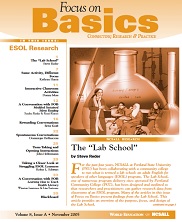According to the US Department of Education’s Report to Congress for the year 2002-2003, English for speakers of other languages (ESOL) students make up 43 percent of the learners served by USDOE-funded adult basic education programs, and 52 percent of the ESOL learners are at beginning levels. So it comes as no surprise that NCSALL’s ESOL Lab School, a joint project of Portland (Oregon) University and Portland Community College, decided to study the learning processes of beginning-level ESOL students. Many, but not all, of the articles in this issue are written by researchers and teachers from the Lab School.
In our cover article, Steve Reder, director of the ESOL Lab School, describes the focus of the research and how it is conducted. Researcher Kathryn Harris reports on one aspect of her study of pair work in the ESOL classroom. Learners she studied individualized their pair work, adapting the activities to their language learning needs. Read about how to ensure that this happens in your classroom in the article that starts on page 7; turn to page 11 for pair activities provided by Donna Moss of Arlington, VA.
Sustained silent reading has been found to encourage many students to read: does it do the same with beginning-level ESOL learners? It is a viable practice with this group, explain Sandra Banke and Reuel Kurzet, who participated in this Lab School study. Their experiences and suggestions are in the article that starts on page 12.
To improve their students’ speaking and listening skills, teachers often set up conversation groups. What if the conversation leaders were university students who studied immigration and cultural adaptation as well as strategies for initiating and keeping conversations going? Betsy Kraft chronicles her classes’ experiences leading conversations with Lab School students; see page 16.
Anyone who has taught an ESOL class with students from a variety of language backgrounds has noticed the chatter that goes on, in English, during breaks. Dominique Brillanceau was curious about whether this casual conversation occurs in class as well, and, if it does, what role it plays in learning. She shares her observations from her Lab School study, page 22.
Starting conversations can be hard for anyone; it’s even harder in a new language. John Hellermann explored the nuance of initiating and turn-taking in conversations in Lab School classes. He provides some suggestions on how to help learners hone this skill; go to page 25 for his report.
Some ESOL learners get stuck, and teachers struggle to find out why. Robin Schwarz, now of Ohio, shares case studies from her years of work with ESOL learners and teachers and provides tips on how to find out what might be the problem, page 29.


